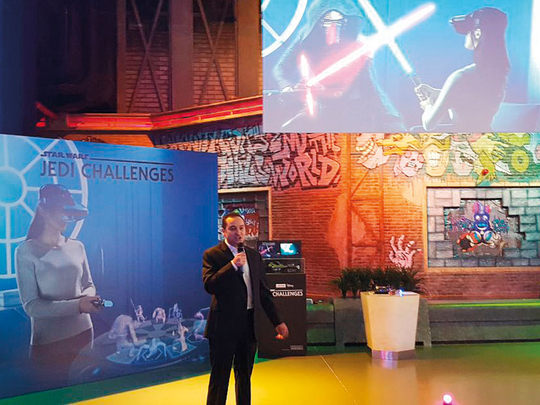
Dubai: Lenovo is allowing fans to experience Star Wars in a new and exciting way at home much before the next movie in the popular series is released next month.
The Chinese company in partnership with Disney is bringing Star Wars: Jedi Challenges, a new smartphone-powered augmented reality game, on its Mirage headset.
Augmented reality has been slow to take off when compared to virtual reality globally and in the Middle East, but smartphone-based AR is getting a bit of a boost right now.
There’s still a dearth of commercially available headsets even though both Apple and Google are investing in it.
Meta 2 AR headset is priced around $900 (Dh3,300) while Microsoft’s HoloLens is close to $3,000 but Lenovo has come out with an affordable solution.
The smartphone-tethered Mirage headset is priced at Dh1,199 while Windows PC-tethered Lenovo Explorer for Dh1,899.
The pre-orders for the device are already opened and will be available from 15th of this month.
Mohammad Hilili, General Manager for Lenovo Gulf, Saudi Arabia and East Africa, told Gulf News that Lenovo sees demand for mixed reality (combination of augmented reality and virtual reality) headsets to grow in future.
“Today, we have the technology at a mainstream level in order to serve larger audiences at an affordable price point. The applications for mixed reality is limitless,” he said.
App development
With the Mirage headsets, he said that users can only play Star Wars: Jedi Challenges. The Star Wars characters, objects and described experiences only appear as augmented reality images through the headset.
There are six levels and each level has six challenges. It works on certain Android and iPhone devices.
“There are challenges in terms of apps currently in the apps stores. It took us two years to develop the app with Disney but there are around 2,000 apps for Lenovo Explorer on Windows platform,” Hilili said.
The package comes with Holographic Tracking Beacon, Lightsaber controller and Mirage headset.
To get started, users need to download the game on to the phone and then slide the phone into the tray located for the phone on the headset. As you start the game, instructions will be offered on where to put the beacon and the headset’s two cameras track the user’s location in the room.
“One of the great things about augmented reality is that you can see other people — while in VR, you’re cut off from your surroundings,” Hilili said.
“We’re taking the AR concept to reality. Eventually, multiplayer mode will be available, so you’ll be able to play lightsabre duels with your friends. This is just the beginning for us,” he said.
AR on mobile devices
Jitesh Ubrani, senior research analyst at International Data Corporation, said that AR headsets are also on track to account for over $30 billion (Dh110.2 billion) in revenue by 2021 globally, almost twice that of VR, as most of the AR headsets will carry much higher average selling prices with earlier adopters being the commercial segment.
He said that most consumers will experience AR on mobile devices, although it’s only a matter of time before Apple’s ARKit- and Google’s ARCore-enabled apps make their way into consumer-grade headsets.
Apple doesn’t have a hardware “headset” for AR yet. It entered the AR space this October with the iOS 11.
VR headsets will account for more than 90 per cent of the market until 2019 while AR will account for the rest. In the final two years of the forecast, IDC expects AR headsets to experience exponential growth as they capture a quarter of the market by the end of the forecast.
Shipments of AR and VR headsets are expected to reach 13.7 million units in 2017 globally, growing to 81.2 million units by 2021 with a compound annual growth rate of 56.1 per cent.
“Most people just associate AR/VR with gaming — as that is the ‘use case’ we have seen the most in the UAE so far,” said Nabila Popal, senior research manager at IDC.
While AR headsets are poised for long-term growth along with a profound impact on the way businesses and consumers compute, she said that VR headsets will drive a near-term shift in computing.
“The bigger challenge is the slow growth in content that appeals to a mass audience and cross-platform support for existing content,” she said.
Factbox: Compatibility
The smartphones compatible with Mirage are iPhone 8 Plus, iPhone 8, iPhone 7 Plus, iPhone 7, iPhone 6s Plus, iPhone 6s, iPhone 6 Plus, iPhone 6, Samsung Galaxy S8, Galaxy S7 edge, Galaxy S7, Google Pixel XL, Google Pixel, Moto Z Force Edition and LG G6.










